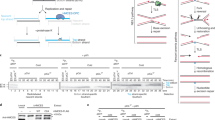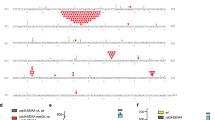Abstract
Four distinct DMA ligase activities (I-IV) have been identified within mammalian cells1–3. Evidence has indicated that DNA ligase I is central to DMA replication4–7, as well as being involved in DNA repair processes8,9. A patient with altered DNA ligase I displayed a phenotype similar to Bloom's syndrome, being immunodeficient, growth retarded and predisposed to cancer10. Fibroblasts isolated from this patient (46BR) exhibited abnormal lagging strand synthesis11,12 and repair deficiency13–15. It has been reported that DNA ligase I is essential for cell viability16, but here we show that cells lacking DNA ligase I are in fact viable. Using gene targeting in embryonic stem (ES) cells, we have produced DNA ligase l-deficient mice. Embryos develop normally to mid-term, when haematopoiesis usually switches to the fetal liver. Thereupon acute anaemia develops, despite the presence of erythroid-committed progenitor cells in the liver. Thus DNA ligase I is required for normal development, but is not essential for replication. Hence a previously unsuspected redundancy must exist between mammalian DNA ligases.
This is a preview of subscription content, access via your institution
Access options
Subscribe to this journal
Receive 12 print issues and online access
$209.00 per year
only $17.42 per issue
Buy this article
- Purchase on Springer Link
- Instant access to full article PDF
Prices may be subject to local taxes which are calculated during checkout
Similar content being viewed by others
References
Barnes, D.E. et al. Human DNA ligase I cDNA: cloning and functional expression in Saccharomyces cerevisiae. Proc. Natl. Acad. Sci. USA 87, 6679–6683 (1990).
Tomkinson, A.E., Roberts, E., Daly, G., Totty, N.F. & Lindahl, T. Three distinct DNA ligases in mammalian cells. J. Biol. Chem. 266, 21728–21735 (1991).
Wei, Y.-F. et al. Molecular cloning and expression of human cDNAs encoding a novel DNA ligase IV and DNA ligase III, an enzyme active in DNA repair and recombination. Mol. Cell. Biol. 15, 3206–3216 (1995).
Wu, W. et al. A17S multiprotein form of murine cell DNA polymerase mediates polyomavirus DNA replication in vitro. J. Biol. Chem. 54, 32–46 (1994).
Applegren, N. et al. Further characterization of the human cell multiprotein DNA replication complex. J. Biol. Chem. 59, 91–107 (1995).
Turchi, J.J., Huang, L., Murante, R.S., Kim, Y. & Bambara, R.A. Enzymatic completion of mammalian lagging-strand DNA replication. Proc. Natl. Acad. Sci. USA 91, 9803–9807 (1994).
Waga, S., Bauer, G. & Stillman, B. Reconstitution of complete SV40 DNA replication with purified replication factors. J. Biol. Chem. 269, 10923–10934 (1994).
Montecucco, A. et al. Late induction of human DNA ligase I after UV-C irradiation. Nud. Acids Res. 23, 962–966 (1995).
Aboussekhra, A. et al. Mammalian DNA nucleotide excision repair reconstituted with purified protein components. Cell 80, 859–868 (1995).
Webster, A.D.B., Barnes, D.E., Arlett, C.F., Lehmann, A.R. & Lindahl, T. Growth retardation and immunodeficiency in a patient with mutations in the DNA ligase I gene. Lancet 339, 1508–1509 (1992).
Lönn, U., Lönn, S., Nylen, U. and Winblad, G. Altered formation of DNA replication intermediates in human 46BR fibroblast cells hypersensitive to 3-aminobenzamide. Cardnogenesis 10, 981–985 (1989).
Prigent, C., Satoh, M.S., Daly, G., Barnes, D.E. & Lindahl, T. Aberrant DNA repair and DNA replication due to an inherited enzymatic defect in human DNA ligase I. Mol. Cell. Biol. 14, 310–317 (1994).
Teo, I.A., Arlett, C.F., Harcourt, S.A., Priestley, A. & Broughton, B.C. Multiple hypersensitivity to mutagens in a cell strain (46BR) derived from a patient with immune-deficiencies. Mut. Res. 107, 371–386 (1983).
Henderson, L.M., Arlett, C.F., Harcourt, S.A., Lehmann, A.R. & Broughton, B.C. Cells from an immunodeficient patient (46BR) with a defect in DNA ligation are hypomutable but hypersensitive to the induction of sister chromatid exchanges. Proc. Nail. Acad. Sci. USA 82, 2044–2048 (1985).
Lehmann, A.R. et al. Relation between the human fibroblast strain 46BR and cell lines representative of Bloom's syndrome. Cancer Res. 48, 6343–6347 (1988).
Petrini, J.H.J., Xiao, Y. & Weaver, D.T. DNA ligase I mediates essential functions in mammalian cells. Mol. Cell. Biol. 15, 4303–4308 (1995).
Barnes, D.E., Tomkinson, A.E., Lehmann, A.R., Webster, A.D.B. & Lindahl, T. Mutations in the DNA ligase I gene in an individual with immunodeficiencies and cellular hypersensitivity to DNA-damaging agents. Cell 69, 495–504 (1992).
Stacey, A. et al. Use of double-replacement targeting to replace the murine α-lactalbumin gene with its human counterpart in embryonic stem cells and mice. Mol. Cell. Biol. 14, 1009–1015 (1994).
Selfridge, J., Pow, A.M., McWhir, J., Magin, T. & Melton, D.W. Gene targeting using a mouse HPRT minigene/HPRT-deficient embryonic stem cell system: Inactivation of the mouseERCC-1 gene.. Som. Cellmolec. Genet. 18, 325–336 (1992).
Metcalf, D. & Moore, M.A.S. Haemopoietic Cells (North-Holland, Amsterdam, 1971)
Montecucco, A. et al. DNA ligase I gene expression during differentiation and cell proliferation. Nucl. Acids Res. 20, 6209–6214 (1992).
Chan, J.Y.-H. & Becker, F.F. DNA ligase activities during hepatocarcinogenesis induced by N-2-acetylaminofluorene. Carcinogenesis 6, 1275–1277 (1985).
Gariboldi, M. et al. Genetic mapping and expression analysis of the murine DNA ligase I gene. Mol. Cardnogenesis 14, 71–74 (1995).
McWhir, J., Selfridge, J., Harrison, D.J., Squires, S. & Melton, D.W. Mice with DNA repair gene (ERCC-1) deficiency have elevated levels of p53, liver nuclear abnormalities and die before weaning. Nature Genet. 5, 217–224 (1993).
Ellis, N.A. et al. The Bloom's syndrome gene product is homologous to RecQ helicases. Cell 83, 655–666 (1995).
Jessop, J.K. & Melton, D.W. Comparison between cDNA clones encoding murine DNA ligase I. Gene. 160, 307–308 (1995).
Thompson, S., Clarke, A.R., Pow, A.M., Hooper, M.L. & Melton, D.W. Germ line transmission and expression of a corrected HPRT gene produced by gene targeting in embryonic stem cells. Cell 56, 313–321 (1989).
Tomkinson, A.E., Lasko, D.D., Daly, G. & Lindahl, T. Mammalian DNA ligases Catalytic domain and size of DNA ligase I.. J. Biol. Chem. 265, 12611–12617 (1990).
Lorimore, S.A., Pragnell, I.B., Eckman, L. & Wright, E.G. Synergistic interactions allow colony formation in vitro by murine haemopoietic stem cells. Leuk. Res. 14, 481–489 (1990).
Freshney, M.G. in Culture of Haematopoietic Cells (eds Freshney, R.I., Pragnell, I.B. and Freshney, M.G.) 265–268 (Wiley-Liss, New York, 1994).
Noguiez, P., Barnes, D.E., Mohrenweiser, H.W. & Lindahl, T. Structure of the human DNA ligase I gene. Nucl. Acids Res. 20, 3845–3850 (1992).
Author information
Authors and Affiliations
Rights and permissions
About this article
Cite this article
Bentley, D., Selfridge, J., Millar, J. et al. DNA ligase I is required for fetal liver erythropoiesis but is not essential for mammalian cell viability. Nat Genet 13, 489–491 (1996). https://doi.org/10.1038/ng0896-489
Received:
Accepted:
Issue Date:
DOI: https://doi.org/10.1038/ng0896-489
This article is cited by
-
Two-tiered enforcement of high-fidelity DNA ligation
Nature Communications (2019)
-
Structures of DNA-bound human ligase IV catalytic core reveal insights into substrate binding and catalysis
Nature Communications (2018)
-
Partial complementation of a DNA ligase I deficiency by DNA ligase III and its impact on cell survival and telomere stability in mammalian cells
Cellular and Molecular Life Sciences (2012)
-
Crucial role for DNA ligase III in mitochondria but not in Xrcc1-dependent repair
Nature (2011)
-
Genetic interaction between DNA polymerase β and DNA-PKcs in embryogenesis and neurogenesis
Cell Death & Differentiation (2005)



